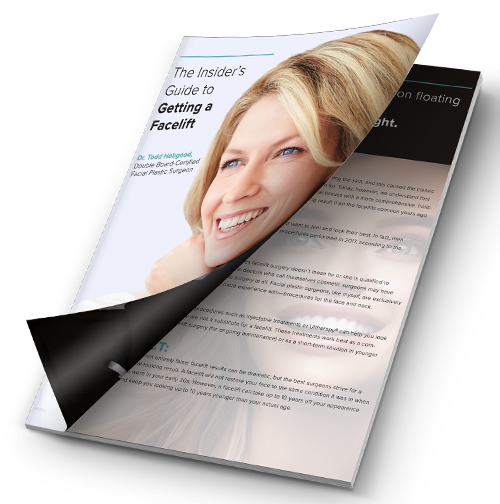A facelift tightens loose, saggy skin and takes years off a patient’s appearance. However, like any other surgery, there are risks and rewards associated with an elective procedure. Many patients want to know how potentially dangerous a facelift procedure can be. Damaging delicate facial tissues or nerves below the tissue can pose health and cosmetic problems.
As a double board-certified facial plastic surgeon, I want my patients to be informed and confident in their decision to undergo facelift surgery. Here is what you can expect from facelift surgery and how you can achieve safe, satisfying results.
What Is a Facelift and How Is it Performed?
A facelift is an elective surgery designed to create a more youthful appearance by firming and smoothing the skin in a way that looks natural. Facelift surgery encompasses a range of different techniques that are more or less invasive, depending on the needs of each patient. The procedure is ideal for men and women concerned about jowls, sagging cheeks, and lines around the mouth. I often combine a facelift with neck lift surgery.
The surgery begins with a plastic surgeon making an incision that extends from the ear to the hairline. The surgeon uses incisions to get access to a layer of muscle and tissue just below the skin called the SMAS (superficial musculoaponeurotic system). Some surgeons limit their surgery to this level, which is called a SMAS facelift.
A deep plane facelift involves accessing the area below the SMAS. This is the most advanced facelift technique and one that I prefer because it produces more dramatic and longer-lasting results. After elevating the muscle and tissue, I trim excess skin and then suture the incisions closed. The surgery takes around 4 hours.

A Must-Have for Facelift Patients
"The Insider's Guide to Getting a Facelift" is the definitive e-book that distinguishes facts from myths and describes the journey of a facelift patient with engaging content and easy-to-understand illustrations.
Double board-certified facial plastic surgeon Dr. Todd Hobgood is one of the leading facelift experts in the U.S., and he's drawn on years of experience to create this Insider's Guide.
Dr. Hobgood's Insider's Guide describes:
- Why modern facelift techniques create results that look natural
- Who is a good candidate for a facelift
- What the difference is between a full and a mini facelift
- When you can expect to see friends socially after a facelift
Submit the form below to receive our free eGuide as part of a short series of emails on Facelift.
Fields marked * are required.
Who Is a Good Facelift Candidate? Which Preexisting Conditions May Affect Surgery?
Ideal candidates for facelift surgery are those who are in overall good health and refrain from nicotine products. Good skin elasticity and bone structure give the best facelift results.
Those with certain preexisting conditions could potentially be more at risk during treatment. When reviewing your medical history, your doctor will take a look at:
- Blood pressure
- Blood clotting
- Smoking
- Drug use
- Allergies
- Medications currently being taken
A facelift is not recommended for anyone with significant health problems such as high blood pressure or diabetes. Tobacco use also increases the risk of complications after surgery.
Facelift Before and After Photos
What Are the Possible Risks and Complications Involved With a Facelift?
Facelift surgery is a well-established procedure with a good safety track record when performed by a board-certified plastic surgeon. However, any surgery comes with a certain amount of risk. Some potential side effects include:
- Bruising
- Bleeding
- Infection
- Numbness
- Tissue death
Most of these issues are created due to infection or nerve damage. Fever, pain, and excessive swelling are common warning signs of potential issues. If you experience any of these concerns after surgery, seek medical help.
How Can I Make My Facelift as Safe as Possible?
Patients can follow some practical tips to make their facelift as safe as possible. Maintain a healthy lifestyle and avoid smoking and other nicotine products. Patients should also stop taking aspirin or other blood thinners at least two weeks before their surgery. In the end, though, there is one best way to make your facelift safe: find a board-certified plastic surgeon.
Most surgery complications occur when inexperienced doctors perform facelift surgery. If the room isn’t well sanitized, or a surgeon is unfamiliar with the procedure, patients may suffer from an infection or lackluster results. Board-certified facial plastic surgeons undergo years of extensive training focused exclusively on facial procedures and operate in safe, highly sanitized rooms. It’s not worth it to cut corners or shop around for a cheap deal when you’re looking for a plastic surgeon. The best way to stay healthy is to find a plastic surgeon you can truly trust.
If you’re in the Phoenix or Scottsdale area and interested in facelift surgery, browse our before-and-after photos and request a consultation. You can also call our practice office by phone at (480) 214-9955 to schedule an appointment.











I use to be so pretty….and now I’m not, help. It’s very sad to get old and not age well., literally.
Age is certainly something that happens to all of us. It can be frustrating and even saddening some days. I think we all want to show to the world on the outside how we really feel on the inside. To me it’s a lot about harmony. Your sentiments are certainly those that we all can relate to.